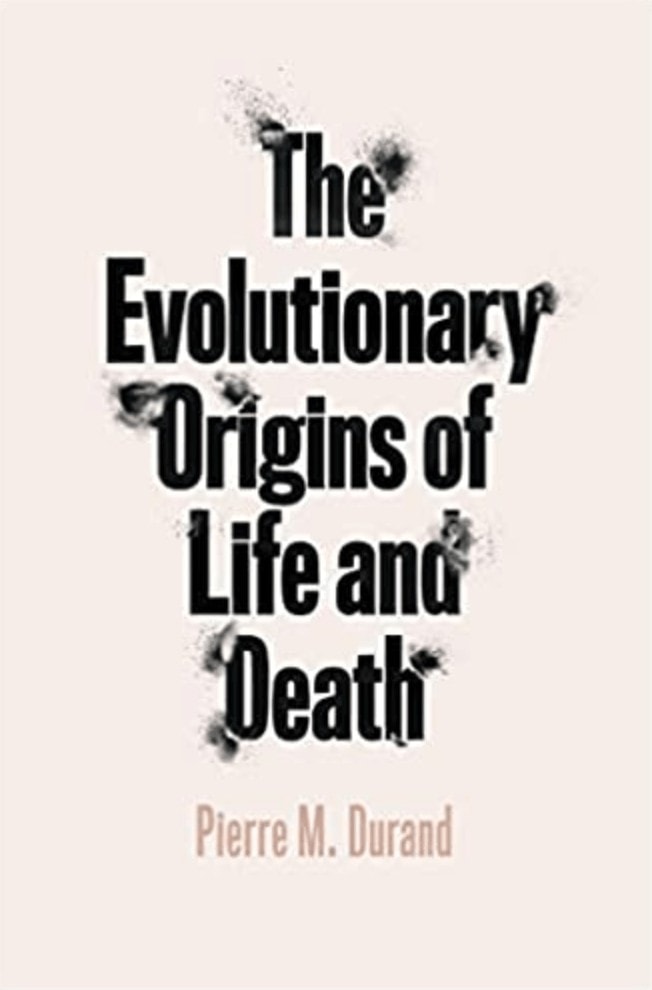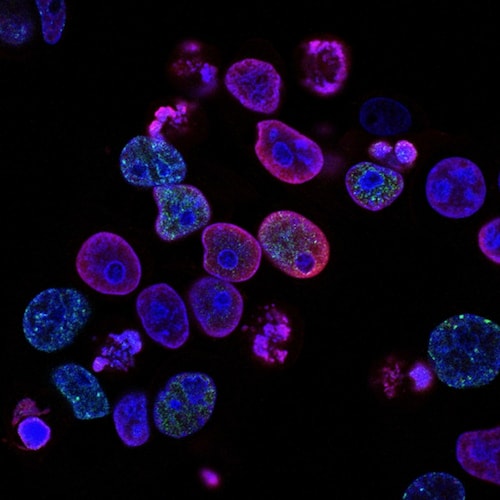Durand, P. (2020). The Evolutionary Origins of Life and Death. University of Chicago Press.
 All bolded terms are defined at the bottom of this post.
All bolded terms are defined at the bottom of this post.
Durand is an evolutionary biologist and clinical doctor. His research interests led him to study the processes of programmed cell death (PCD) over the last five years. In Evolutionary Origins of Life and Death, he presents discussions on the origin of life and death for unicellular organisms, different findings in the biology of life and processes of death, as well as his interpretations of their intertwined evolution. As a biological anthropologist and thanatologist, I have mostly approached the biological and conceptual aspects of life and death of multicellular organisms (humans) from a perspective of duality and opposition. Durand’s narrative was an eye-opener on their complementarity.
Evolutionary Origins of Life and Death is well organised, concise, and easy to navigate. It is divided into three parts: the first introduces and discusses the evolutionary origin and biology of life, the second discusses these aspects of death, while the third integrates the different concepts and theories necessary to grasp their putative co-evolution. Durand presents the concepts, theories and ideas in a concise manner, drawing examples from fungi, bacteria and algae. As suggested in the preface, Evolutionary Origins of Life and Death is intended for the general audience with basic biology and natural history knowledge, and Durand ensures the reader has access to the information necessary to understand his theory throughout the book. That being said, the concepts and ideas presented should also appeal to the expert in evolutionary biology interested in the possible co-evolution of life and death. Since the chapters are well organised and clearly defined, readers can easily skim over their area of expertise and continue without compromising their understanding of the underlying rationale presented.
In part one, Durand beautifully integrates philosophy and empirical science to describe and define life and uses a holistic approach to present theories of its origin. Taking into account theories of evolution, the origin of life is either studied as a biogenesis from abiotic material (transition from abiotic to biotic) or as a transition from a reproducible individual to a more complex and stable living organism (Evolutionary Transition in Individuality – ETI). Durand explores the concepts of ET – ETI and postulates that the boundary between abiotic-biotic «is an artificial construct; the origin of life was not a binary, before-after, phenomenon» (Durand 2020:53) by contrasting different elements of the abiotic and biotic worlds, as well as elements of lower-level and higher-level replicating units (simple, non-individual replicators to more complex living organism). He also discusses LUCA (Last Unknown Common Ancestor) and the RNA world hypothesis, discussing the possibility that there might be several sources of life. This is one of the ideas that really struck me since, as an anthropologist, I intuitively think of LUCA as a multicellular DNA-based organism when considering our human lineage (hominins, primates, mammals, etc.) and DNA-based genome. Other topics addressed in this section include mobile genome elements, individualism and selfishness vs groups and altruism, concepts of fitness and the life history fitness components, with a focus on reproduction and viability, and investment trade-offs. The synthesis (chapter 7) presents the evolution of life in eight steps accompanied by figures, based on the theoretical, philosophical, empirical and genomic data presented in the previous chapters. The steps are a good and concise representation of the ideas and concepts discussed thus far, and comprise of:
1) Emergence of biologically relevant molecules;
2) Passive replicators (molecule or group of molecules replicating as a unit);
3) Enzyme-mediated replication;
4) Compartmentalization;
5) Lower-level replicating units (LRUS);
6) Functional and structural integration of the components making up LRUS;
7) Evolutionary transition to higher-level replicating units;
8) Protocells
Part two presents different types of cell death and distinguishes between death as a result of extraneous factors (incidental death), programmed cell death as a by-product of other selected traits (Ersatz PCD) and programmed cell death as an evolutionary adaptation (true PCD). Durand focuses on true PCD of single-celled organisms to explore the evolutionary origin of death. He highlights the paradox of true PCD in single-celled organisms: if death is detrimental to the single-cell by marking the end of its individual life (as opposed to multicellular organisms), how could PCD be an advantageous trait selected for in unicellular organisms? He proposes that «death can enhance life by increasing inclusive fitness in a clonal population and some forms of death played a role in the evolution of more complex life» (Durand 2020:75). Although PCD marks the end of the cell, it can be altruistic and can provide advantages at different units or levels of selection (individual, group, kinship, etc.), which are explored in this section. For instance, the selective death of a unicellular organism can increase the viability of other surrounding unicellular organisms by increasing the ratio of available resources and reducing competition amongst them. Just like menopause is a counterintuitive evolutionary advantage in women by limiting the number of children they can have, it also increases the chance of their children and their children’s children to survive (by increasing the available resources and parental investment) hence providing an evolutionary advantage for the mother’s DNA to survive in her offspring. In this case, however, the surviving unicellular organisms would not be bearing the same RNA-DNA as the dead cell, which renders this concept of altruistic death even more intriguing to me, a biological anthropologist. Once again, the last chapter is dedicated to a synthesis of the eight steps of the origin of death presented in part two.
Saving the best for last, the third part is dedicated to the culmination of the interpretations of the origins of life and death and Durand’s view of their co-evolution. His discussion of the origin and evolution of life and death touches upon topics such as stress-induced innovation, chimeric groups and the evolution of individuality, conflict resolutions or self-sacrifice, etc. He claims that group selection is important for both life and death to emerge, such that natural selection acted on the properties of a group as a whole (chimeric groups – composed of different cells) rather than the individual. His position is that life and death are not oppositional; death rather augments «life in more fundamental ways than previously imagined» (Durand 2020: 155). As he suggests, cell death has the potential to provide support and resources for the surrounding organisms, increase the fitness of surviving cells, reduce competition between cells, resolve potential DNA-RNA conflicts in the evolution towards multicellular organisms, etc., consequently augmenting life itself. His rationale is well laid out, straightforward and insightful.
I particularly appreciated the idea that PCD «presented new ways for individuals to communicate and share resources» (Durand 2020:141) amongst single-celled organisms, which reminded me of the concept of panpsychism, the consciousness as a property of matter beyond the consciousness generated by the brain of multicellular organisms. Perhaps the consciousness of death and the origin of grief goes further than previously imagined? Grief is a behaviour shared between humans and other species (great apes, dolphins, orcas, elephants), however, its origin or the consciousness of death itself has not been established yet. Although proof can date back to early Homo with evidence of intentional burials from Neandertals, the consciousness of death is a cognitive ability that is difficult to investigate or perhaps imagine in other species, whether them being in our human lineage or other evolutionary trees. If PCD presents ways to communicate altruistic behaviours and share resources, are the surrounding cells aware of its passing when collecting these new resources? And if so, can we use this premise to investigate the death consciousness in complex multicellular organisms?
Overall, as Durand’s first book, Evolutionary Origins of Life and Death is beautifully written and thoughtfully presented. I strongly recommend it to any biological anthropologist or evolutionary biologist interested in studying the topic of the origins of life or death and I will be looking forward to his next work.
Lexicon
Biogenesis: Origin of living organisms.
DNA-based genome: The genome is the entirety of the genetic material of an organism.
Evolutionary Transition in Individuality – ETI: «ETI theory explains the process by which HRUs – Higher-Level Replicating Units – emerged from populations of LRUs – lower-Level Replicating Units – via group selection» (Durand 2020:54).
Inclusive fitness: Inclusive fitness suggests that an organism’s fitness isn’t limited to the individual organism but is rather dependent on cooperation with other organisms in the population. An increased fitness means more genes can be passed down to the next generation. Thus, increasing inclusive fitness means that the cooperation and fitness of the population increase.
Life history fitness: In its general sense, fitness is a principle used in evolutionary theory to measure the ability (success) of an organism to pass its genes (hereditary traits) to the next generation. It includes its ability to survive long enough to be able to replicate/reproduce and thus pass its genes to the next generation (new cells/offspring). Here, life history is a concept that takes into account all factors (intrinsic or extrinsic) that could impact fitness.
RNA world hypothesis: RNA World Hypothesis is the assumption that RNA, or a similar molecule, «was the first molecule that included hereditary genotypic information and due to its enzymatic activity could catalyze its own or others’ replication» (Durand 2020:35).
Stress-induced innovation: Evolutionary innovation as a response to a stressor.
Transition from abiotic to biotic: Transition from non-living to living organism, the general concept of Evolutionary Transition – ET.
IMAGE: Photo by National Cancer Institute on Unsplash.
This review is part of our ‘Death and Mourning’ call for reviews.



